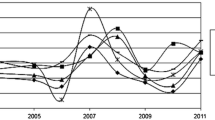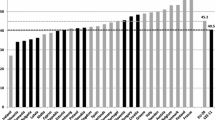Abstract
The paper addresses the issue of convergence with the EU for nine countries: Albania, Bosnia and Herzegovina, Georgia, Moldova, Serbia, the Former Yugoslav Republic of Macedonia, Turkey, Montenegro and Ukraine. All that are at different stages of EU candidacy that could eventually lead to full membership. Some are officially recognized as candidate countries while others are at the stage of an association agreement. The presence of convergence is examined in terms of two macroeconomic indices: GDP per capita and GDP per person employed. Panel unit root tests as well as univariate unit root tests are estimated for the period 1997–2016. In broad terms, the empirical findings reported herein indicate a lack of convergence with the EU irrespective of the metric used. However, they indicate a process of in-group convergence mostly in terms of GDP per person employed.
Similar content being viewed by others
Notes
The corresponding 1997–2016 average is 8.9% for Bulgaria and 9.5% for Romania.
For 2016, in PPPs and constant 2011 international $ as the data in Table 3.
It should be noted here that there is no formal criterion that can be used in order to choose among the three models (Altinay 2005). However, Ben-David and Papell (1997) report that if a trend is present in a series then using in the estimations a model without trend is possible to fail to capture important data characteristics. Most of the series used in analysis here do not exhibit an upward or downward trend. Nevertheless, we also estimate Model C (not reported for reasons of brevity but available from the authors upon request) but the general findings and concomitant conclusion dot not change in any substantive manner.
It is possible to correct for possible serial correlation by including an additional term in the model such as \(\Delta \widetilde{S}_{t - 1}\) (Amsler and Lee 1995).
References
Altinay G (2005) Structural breaks in long-term Turkish macroeconomic data, 1923–2003. Appl Econom Int Dev 5:117–130
Amsler C, Lee J (1995) An LM test for a unit root in the presence of a structural change. Econom Theory 11:359–368
Apergis N, Panopoulou E, Tsoumas C (2010) Old wine in a new bottle: growth convergence dynamics in the EU. Atl Econ J 38:169–181
Ayala A, Cunado J, Gil-Alana L (2013) Real convergence: empirical evidence for Latin America. Appl Econ 45(22):3220–3229
Baltagi B (2005) Econometric analysis of panel data, 3rd edn. Wiley, Hoboken
Belke A, Schneider J (2013) Portfolio choice of financial investors and European business cycle convergence: a panel analysis for EU countries. Empirica 40:175–196
Belke A, Haskamp U, Schnabl G (2018) Beyond Balassa and Samuelson: real convergence, capital flows, and competitiveness in Greece. Empirica 45:409–424
Ben-David D, Papell D (1997) Slowdowns and meltdowns: post war growth evidence from 74 countries. Rev Econ Stat 28:561–571
Beyaert A, Camacho M (2008) Panel unit root tests and real convergence: an application to the EU enlargement process. Rev Dev Econ 12:668–681
Bongardt A, Torres F (2013) Forging sustainable growth: the issue of convergence of preferences and institutions in EMU. Intereconomics 2:72–92
Borsi M, Metiu N (2015) The evolution of economic convergence in the European Union. Empir Econ 48(2):657–681
Breitung J (2000) The local power of some unit root tests for panel data. Adv Econom 15:161–177
Ceylan R, Abiyev V (2016) An examination of convergence hypothesis for EU-15 countries. Int Rev Econ Finance 45:96–105
Chapsa X, Katrakilidis C (2014) Assessing economic convergence in the EU: is there a perspective for the ‘cohesion countries’? Appl Econ 46(33):4025–4040
Chapsa X, Katrakilidis C, Tabakis N (2015) Investigating the convergence hypothesis in the EU: more evidence accounting for structural breaks. In: Karasavvoglou A et al (eds) EU crisis and the role of the periphery. Springer, Switzerland, pp 21–39
Choi I (2001) Unit root tests for panel data. J Int Money Finance 20:249–272
Dauderstadt M (2014) Convergence in crisis: European integration in jeopardy, Friedrich Ebert Stiftung. http://library.fes.de/pdf-files/id/ipa/11001.pdf. Accessed 25 Apr 2017
Dawson JW, Strazicich MC (2010) Time-series tests of income convergence with two structural breaks: evidence from 29 countries. Appl Econ Lett 17:909–912
Dickey D, Fuller W (1979) Distribution of the estimators for autoregressive time series with a unit root. J Am Stat Assoc 74:427–431
Dickey D, Fuller W (1981) Likelihood ratio statistics for autoregressive time series with a unit root. Econometrica 49:1057–1072
Dobrinsky R (2003) Convergence in per capita income levels, productivity dynamics and real exchange rates in the EU acceding countries. Empirica 30:305–334
Emvalomatis G (2017) Is productivity diverging in the EU? Evidence from 11 member states. Empir Econ 53:1171–1192
Evans P (1998) Using panel data to evaluate growth theories. Int Econ Rev 39:295–306
Firgo M, Huber P (2014) Convergence as a heterogeneous process: what can be learnt about convergence in EMU from regional experiences? Empirica 41:129–151
Galvão A, Reis Gomes FA (2007) Convergence or divergence in Latin America? A time series analysis. Appl Econ 39(11):1353–1360
Hadri K (2000) Testing for stationarity in heterogeneous panel data. Econom J 3:148–161
Hlouskova J, Wagner M (2006) The performance of panel unit root and stationarity tests: results from a large scale simulation study. Econom Rev 25:85–116
Huang H, Lin P, Yeh C (2011) Price level convergence across cities? Evidence from panel unit root tests. Appl Econ Lett 18:87–93
Icoz G (2011) Turkey’s path to EU membership: an historical institutionalist perspective. J Contemp Eur Stud 19(4):511–521
Im K, Pesaran M, Shin Y (2003) Testing for unit roots in heterogenous panels. J Econom 115:53–74
Im K, Lee J, Tieslau M (2005) Panel LM unit-root tests with level shifts. Oxf Bull Econ Stat 67:393–419
Lau C, Marco K, Demir E, Bilgin M (2016) A nonlinear model of military expenditure convergence: evidence from Estar nonlinear unit root test. Def Peace Econ 27(3):392–403
Lee J, Strazicich M (2003) Minimum Lagrange multiplier unit root test with two structural breaks. Rev Econ Stat 85:1082–1089
Levin A, Lin C, Chu C (2002) Unit root tests in panel data: asymptotic and finite-sample properties. J Econom 108:1–24
Lumsdaine R, Papell D (1997) Multiple trend breaks and the unit-root hypothesis. Rev Econ Stat 79:212–218
Lyncker K, Thoennessen R (2017) Regional club convergence in the EU: evidence from a panel data analysis. Empir Econ 52:525–553
Maddala G, Wu S (1999) A comparative study of unit root tests with panel data and a new simple test. Oxf Bull Econ Stat 61:631–652
Martin C, Sanz I (2003) Real convergence and European integration: the experience of the less developed EU members. Empirica 30:205–236
Perron P (1989) The great crash, the oil price shock, and the unit root hypothesis. Econometrica 57:1361–1401
Phinnemore D, Içener E (2016) Holding the door half (?) open: the EU and Turkey 10 years on. J Contemp Eur Stud 24(4):446–462. https://doi.org/10.1080/14782804.2016.1178104
Sondermann D (2014) Productivity in the euro area: any evidence of convergence? Empir Econ 47:999–1027
Strazicich M, Lee J, Day E (2004) Are incomes converging among OECD countries? Time series evidence with two structural breaks. J Macroecon 26:131–145
Tsanana E, Katrakilidis C (2014) Do Balkan economies catch up with EU? New evidence from panel unit root analysis. Empirica 41:641–662
Tsoukalis L (2014) The unhappy state of the union. Europe needs a new grand bargain. Policy network. www.policy-network.net. Accessed 25 April 2017
Vojinovic B, Oplotnik Z, Prochniak M (2010) EU enlargement and real economic convergence. Post-Communist Econ 22(3):303–322
Zivot E, Andrews D (1992) Further evidence on the great crash, the oil-price shock and the unit root hypothesis. J Bus Econ Stat 10:251–270
Acknowledgements
The authors are grateful to two anonymous referees for spotting flaws and inconsistencies in earlier versions and for their insightful detailed comments and constructive suggestions that helped improve the paper. They also wish to sincerely thank Junsoo Lee and Constantinos Katrakilidis for their assistance with the panel LM unit root test code.
Author information
Authors and Affiliations
Corresponding author
Additional information
Publisher's Note
Springer Nature remains neutral with regard to jurisdictional claims in published maps and institutional affiliations.
Rights and permissions
About this article
Cite this article
Kollias, C., Messis, P. Are future enlargement candidate countries converging with the EU?. Empirica 47, 453–473 (2020). https://doi.org/10.1007/s10663-019-09442-9
Published:
Issue Date:
DOI: https://doi.org/10.1007/s10663-019-09442-9




